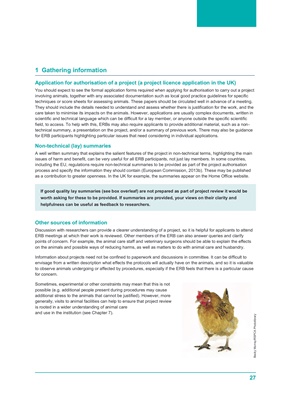
27
1 Gathering information
Application for authorisation of a project (a project licence application in the UK)
You should expect to see the formal application forms required when applying for authorisation to carry out a project
involving animals, together with any associated documentation such as local good practice guidelines for specific
techniques or score sheets for assessing animals. These papers should be circulated well in advance of a meeting.
They should include the details needed to understand and assess whether there is justification for the work, and the
care taken to minimise its impacts on the animals. However, applications are usually complex documents, written in
scientific and technical language which can be difficult for a lay member, or anyone outside the specific scientific
field, to access. To help with this, ERBs may also require applicants to provide additional material, such as a nontechnical
summary, a presentation on the project, and/or a summary of previous work. There may also be guidance
for ERB participants highlighting particular issues that need considering in individual applications.
Non-technical (lay) summaries
A well written summary that explains the salient features of the project in non-technical terms, highlighting the main
issues of harm and benefit, can be very useful for all ERB participants, not just lay members. In some countries,
including the EU, regulations require non-technical summaries to be provided as part of the project authorisation
process and specify the information they should contain (European Commission, 2013b). These may be published
as a contribution to greater openness. In the UK for example, the summaries appear on the Home Office website.
Other sources of information
Discussion with researchers can provide a clearer understanding of a project, so it is helpful for applicants to attend
ERB meetings at which their work is reviewed. Other members of the ERB can also answer queries and clarify
points of concern. For example, the animal care staff and veterinary surgeons should be able to explain the effects
on the animals and possible ways of reducing harms, as well as matters to do with animal care and husbandry.
Information about projects need not be confined to paperwork and discussions in committee. It can be difficult to
envisage from a written description what effects the protocols will actually have on the animals, and so it is valuable
to observe animals undergoing or affected by procedures, especially if the ERB feels that there is a particular cause
for concern.
Sometimes, experimental or other constraints may mean that this is not
possible (e.g. additional people present during procedures may cause
additional stress to the animals that cannot be justified). However, more
generally, visits to animal facilities can help to ensure that project review
is rooted in a wider understanding of animal care
and use in the institution (see Chapter 7).
If good quality lay summaries (see box overleaf) are not prepared as part of project review it would be
worth asking for these to be provided. If summaries are provided, your views on their clarity and
helpfulness can be useful as feedback to researchers.
Becky Murray/RSPCA Photolibrary